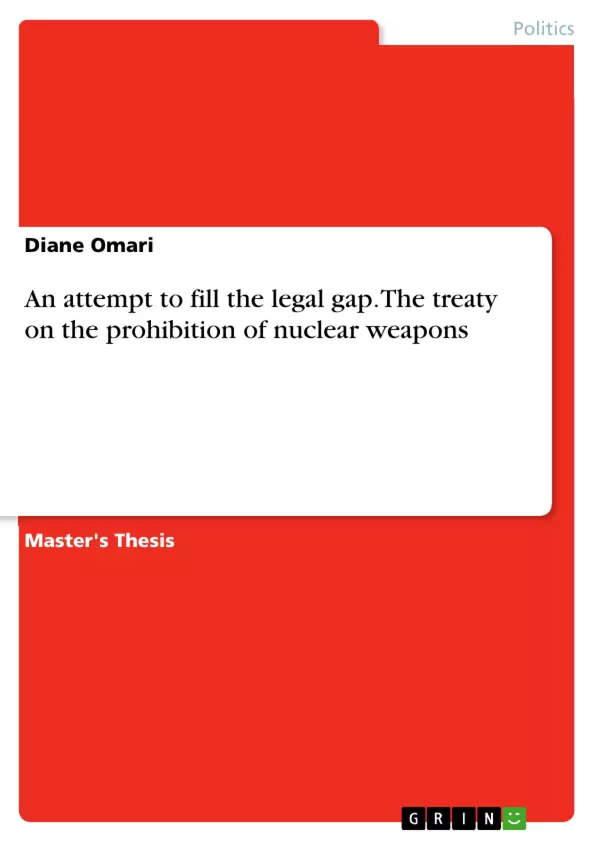This thesis will first outline the background and key conventions that are predecessors to the TPNW. Chapter II will cover thematic similarities between these conventions, and then demonstrate how the ideas codified within these treaties left the issue of the use of nuclear weapons’ legality ambiguous. It will then analyse the ICJ’s famous Advisory Opinion on the matter, and the debates leading up to the acceptance for such a request. Chapter III will discuss the main recurring ideas and issues furthering the need for a convention with clarity on the illegality of nuclear weapons, and analyse the drafting process of the Treaty by observing the contribution of several states, international organizations, and non-governmental organizations (‘NGOs’). Various opinions will be observed to outline the perceived legal impact of the Treaty, considering that most are dubious of the cooperation of nuclear weapons states. Chapter IV will analyse key provisions of the Treaty, its adoption, and voting patterns. This will include a look at the boycotting of the process by states with nuclear weapons and their allies, with a closer observation of the case of the Netherlands, who was the only State voting against the adoption. The thesis will conclude by identifying the potential successes of the Treaty pursuant to goals outlined in the drafting process, and identifying possible recurring issues that may occur with regards to the cooperation of nuclear-weapons states.
The Treaty on the Prohibition of Nuclear Weapons’ likelihood of achieving its aims will depend on the pressure it creates on states that possess nuclear weapons and their efforts towards disarmament. With an analytical view of the drafting process and subsequent voting on the Treaty, it seems the only states likely to sign or ratify the Treaty belong to the group that does not possess them to begin with. Nonetheless, the Treaty may have an effect on nuclear weapon states’ behaviour if it is widely accepted by other states, compelling them to take more aggressive action towards nuclear disarmament. Therefore, while the TPNW’s adoption is a progressive step towards greater certainty on the illegality of nuclear weapons, its success in creating a safer world for humanity will largely depend on the likelihood of states in possession of nuclear weapons to feel some obligation to comply with its provisions.
Inhaltsverzeichnis (Table of Contents)
- CHAPTER 1: INTRODUCTION
- CHAPTER 2: BACKGROUND ON THE REGULATION OF NUCLEAR WEAPONS
- 2.1 MULTILATERAL TREATIES IN FORCE BEFORE THE TPNW
- 2.2 THE INTERNATIONAL COURT OF JUSTICE ON THE ISSUE
- CHAPTER 3: WORKING TOWARDS THE TREATY ON THE PROHIBITION OF NUCLEAR WEAPONS
- 3.1 FACTORS ENTAILING A NEED FOR THE TREATY
- 3.2 DRAFTING PROCESS
- CHAPTER 4: CURRENT PROVISIONS AND STATUS OF THE TREATY
- 4.1 FINAL STRUCTURE OF THE TREATY
- 4.2 ADOPTION AND STATE POSITIONS
- CHAPTER 5: CONCLUDING REMARKS
Zielsetzung und Themenschwerpunkte (Objectives and Key Themes)
This thesis aims to analyze the Treaty on the Prohibition of Nuclear Weapons (TPNW) and its significance in addressing the legality of nuclear weapons in international law. The TPNW, being the first treaty to completely prohibit nuclear weapons, represents a significant step towards achieving nuclear disarmament. The thesis aims to delve into the historical context, drafting process, provisions, and potential impact of the TPNW.
- The historical context and existing legal framework surrounding the regulation of nuclear weapons.
- The factors leading to the need for a comprehensive treaty prohibiting nuclear weapons.
- The drafting process of the TPNW, including the contributions of various states, international organizations, and NGOs.
- The key provisions of the TPNW and its current status, including the adoption process and state positions.
- The potential impact and challenges of the TPNW, particularly in terms of the cooperation of nuclear-weapon states.
Zusammenfassung der Kapitel (Chapter Summaries)
- Chapter 1: Introduction This chapter introduces the complex legal landscape surrounding nuclear weapons, highlighting the lack of a clear universal prohibition and the existing attempts at regulation through multilateral treaties and ICJ rulings. It then focuses on the TPNW as a recent development aimed at achieving concrete nuclear disarmament.
- Chapter 2: Background on the Regulation of Nuclear Weapons This chapter examines the historical context of nuclear weapons regulation, focusing on key multilateral treaties such as the Limited Test Ban Treaty (LTBT) and the Non-Proliferation Treaty (NPT), and their role in decreasing proliferation and addressing the consequences of nuclear weapons use. It also explores the International Court of Justice's (ICJ) pronouncements on the issue, particularly its advisory opinion on the legality of nuclear weapons.
- Chapter 3: Working towards the Treaty on the Prohibition of Nuclear Weapons This chapter delves into the factors motivating the development of the TPNW, emphasizing the need for a clear international legal instrument prohibiting nuclear weapons. It further analyzes the drafting process of the Treaty, examining the contributions of various states, international organizations, and non-governmental organizations (NGOs).
- Chapter 4: Current Provisions and Status of the Treaty This chapter examines the key provisions and structure of the TPNW, focusing on the rules it establishes regarding the illegality of nuclear weapons for States Parties. It also analyzes the Treaty's adoption process, including voting patterns and the positions of states, particularly the nuclear-weapon states and their allies.
Schlüsselwörter (Keywords)
This preview examines the Treaty on the Prohibition of Nuclear Weapons (TPNW), focusing on international law, nuclear disarmament, nuclear weapons, multilateral treaties, the International Court of Justice (ICJ), the Non-Proliferation Treaty (NPT), the Limited Test Ban Treaty (LTBT), nuclear proliferation, and the legality of nuclear weapons.
- Quote paper
- Diane Omari (Author), 2019, An attempt to fill the legal gap. The treaty on the prohibition of nuclear weapons, Munich, GRIN Verlag, https://www.grin.com/document/516611



